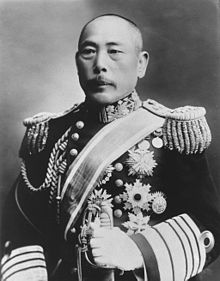Kamimura Hikonojō
Kamimura Hikonojō ( Japanese 上 村 彦 之 丞 ; * May 1, 1849 - August 8, 1916 ) was a Japanese admiral. He served in the Imperial Japanese Navy from 1871 to 1914 and on the Supreme War Council of Japan from 1911 to 1916. During the Russo-Japanese War 1904-1905 he commanded the Japanese Second Fleet, especially in the naval battle near Ulsan and in the naval battle near Tsushima .
Early career
Kamimura was a descendant of a samurai family from the Han Satsuma on the island of Kyushu . In the Boshin War 1868-1869 he served as an infantryman on the imperial side. After the Meiji Restoration , Kamimura entered the Imperial Naval Academy in 1871 as one of the first cadets. His promotion to lieutenant took place in 1879. This was followed by service in various board and staff positions and constant promotions. In 1890 he became corvette captain, and in the following year he received his first command of his own, on the gunboat Maya . In 1893 he took over the small cruiser Chōkai . A week after the outbreak of the First Sino-Japanese War (1894-1895) he became the commander of the new protected cruiser Akitsushima , with which he distinguished himself in the sea battle of Yalu on September 17, 1894. In December 1894 he was promoted to captain.
After the end of the war he held various board and staff positions. In 1899 he was promoted to Rear Admiral and in 1903 to Vice Admiral. In October 1902 he became commander of the reserve fleet.
Russo-Japanese War
Shortly after the beginning of the Russo-Japanese War, he was appointed Commander-in-Chief of the Second Fleet, which should neutralize the Russian cruiser squadron in Vladivostok . He set his flag on the modern, England-built armored cruiser Izumo . When the Russian cruisers succeeded in sinking Japanese troop carriers in the Sea of Japan in April and June 1904, Kamimura was exposed to severe public criticism in Japan; a mob attacked his home and parts of the press told him to commit suicide using hara- kiri. With his victory in the naval battle at Ulsan over the Vladivostok cruiser squadron under Karl Petrovich Jessen on August 14, 1904, when he was able to sink one of the three Russian armored cruisers, he managed to restore his good reputation. In the naval battle of Tsushima in May 1905, he also commanded the Second Fleet, which was mainly used in the fighting during the night and on the second day.
Later career
In December 1905, Kamimura became the commander of the important Yokosuka naval base in Tokyo Bay and a member of the Admiralty Committee. In 1907 he was raised to the nobility as a danshaku (baron). In December 1909 he was given supreme command of the First Fleet (the core of the Japanese battle fleet), and on December 1, 1910, he was promoted to Admiral. From 1911 he served as a member of the Supreme War Council. On May 1, 1914, he retired from active service.
He died in August 1916 and was buried in the temple district of Myohon-ji in Kamakura .
Web links
| personal data | |
|---|---|
| SURNAME | Kamimura Hikonojō |
| ALTERNATIVE NAMES | 上 村 彦 之 丞 (Japanese) |
| BRIEF DESCRIPTION | Japanese admiral |
| DATE OF BIRTH | May 1, 1849 |
| DATE OF DEATH | August 8, 1916 |
